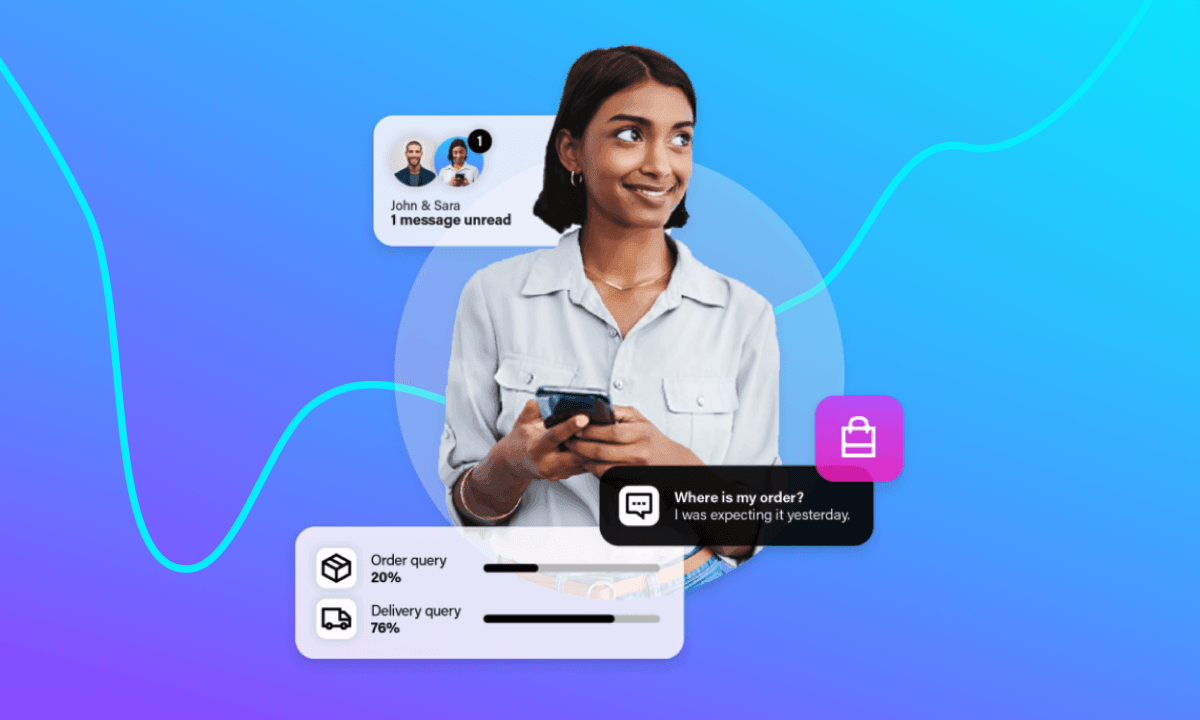Ti preoccupa l’impatto che una recessione potrebbe avere sulla tua attività di e-commerce? Forse da qualche tempo stai pensando di rendere la tua attività a prova di recessione, ma non sei sicuro di quali siano i passi da compiere per raggiungere questo obiettivo.
Non preoccuparti. Abbiamo pensato a voi.
Questo articolo si concentra sull’importanza di costruire un marchio che abbia un approccio incentrato sul cliente e che centralizzi l’assistenza ai clienti e su come questi passi possano aiutare il tuo marchio a prova di recessione.
Sebbene la recessione non sia una fase facile per nessuna azienda, i consigli forniti in questo articolo ti aiuteranno a mantenere il tuo marchio organizzato ed efficiente, a rafforzare in modo significativo le tue attività contro le sfide economiche e a prosperare durante l’inevitabile boom che seguirà.
In questo articolo vedremo:
Cos’è una recessione: una definizione chiara e precisa di cosa sia una recessione.
I potenziali impatti di una recessione sulle aziende di eCommerce: Affronta tutti i principali effetti che una recessione può avere su un marchio di eCommerce.
Come un’esperienza incentrata sul cliente attenua questi impatti: Come rendere la tua attività a prova di recessione con un approccio incentrato sul cliente per stabilizzare le vendite al dettaglio totali.
Come offrire un approccio incentrato sul cliente: Come implementare un approccio incentrato sul cliente per assicurarti di essere pronto ad affrontare eventuali flessioni economiche che il futuro potrebbe riservarti.
Cos’è la recessione?

Innanzitutto, diamo una definizione di recessione. Una recessione è una flessione economica diffusa, prolungata e significativa.
In linea di massima, le recessioni tendono a durare non meno di sei mesi, quindi molti economisti identificano una recessione come due trimestri consecutivi di crescita negativa in un paese.
Le recessioni tendono a produrre un calo della domanda dei consumatori, dell’occupazione e della produzione economica, che può danneggiare un marchio di eCommerce.
Una flessione deve essere pervasiva, duratura e profonda per essere classificata come recessione, ma queste definizioni tendono ad essere fatte da accademici piuttosto che da formule matematiche.
Quali sono i potenziali impatti di una recessione sulle aziende di eCommerce?

Una recessione dovuta a una pandemia globale, al mercato azionario o ad altri fattori può avere un impatto notevole su qualsiasi settore. In un periodo di recessione, le finanze personali calano per i potenziali consumatori e le aziende di commercio digitale si trovano a dover lottare per mantenere i profitti. Ecco alcuni dei principali impatti di una grande recessione su un marchio di e-commerce.
Minori investimenti in strategie di marketing
Quando i soldi sono pochi per un marchio, una delle prime aree che subisce un taglio al budget è il reparto marketing. I brand cercano di assicurarsi la situazione attuale e cercano di tagliare le spese dove possibile.
Per questo motivo, è probabile che tu abbia meno fondi a disposizione per implementare un CRM dettagliato o annunci a pagamento, il che può portare a una minore portata. Come ci si può aspettare, se si coinvolge un numero minore di persone del proprio pubblico di riferimento, gli acquisti del prodotto o del servizio probabilmente rallenteranno per riflettere il cambiamento, con un impatto negativo sui profitti.
Meno traffico sul sito web
Con il calo delle spese di marketing e con la diminuzione delle persone che cercano attivamente i prodotti che offri, diminuirà anche il numero di persone che visitano il tuo sito web.
Con meno persone che visitano organicamente il tuo sito web, i profitti sono destinati a diminuire. Anche se manterrai il tuo tasso di conversione (cosa improbabile e di cui parleremo a breve), la conversione avverrà da un bacino più piccolo e quindi le vendite diminuiranno.
Anche con il miglior sito web possibile, se le persone che lo visitano sono meno numerose e la maggior parte di quelle che lo fanno hanno una mentalità più scettica o cauta, la diminuzione del traffico ridurrà sicuramente i profitti del tuo marchio.
Meno conversioni
Meno budget per il marketing e meno visitatori del sito web non sono gli unici problemi che il tuo marchio potrebbe affrontare durante una recessione. È anche probabile che le conversioni di coloro che visitano il tuo sito diminuiscano.
Durante una recessione, il denaro è più scarso e i consumatori devono decidere quali acquisti possono permettersi e quali devono abbandonare. Anche con le migliori tattiche di conversione, è probabile che le conversioni diminuiscano durante la recessione.
Meno vendite online a causa della diminuzione della spesa dei consumatori
Questi fattori porteranno probabilmente a un calo delle vendite online e a una riduzione dei profitti per il tuo marchio. Con un numero inferiore di persone esposte al tuo marchio online attraverso le pubblicità a pagamento, un numero inferiore di contatti che arrivano al tuo sito web e un tasso di conversione ridotto, i marchi che non adottano un approccio customer-first possono aspettarsi di essere colpiti duramente da una recessione economica.
Come un approccio incentrato sul cliente attenua l’impatto di una recessione
Una buona esperienza del cliente porta a maggiori vendite

Potrebbe non sembrare così se si guarda solo alla parte alta, ma se si va un po’ più a fondo si capisce subito come una forte esperienza del cliente possa portare a maggiori vendite per il tuo marchio.
Gli effetti a catena di un’esperienza eccellente per i clienti possono essere enormi: gli acquirenti saranno più propensi a promuovere il tuo marchio ad amici e parenti e a rilasciare recensioni a cinque stelle che convincono i navigatori ad acquistare e a creare fedeltà al marchio, il che porterà a un maggior numero di acquisti ripetuti.
Durante la recessione i clienti tendono a essere più cauti e scettici quando i soldi sono pochi, quindi avere una forte reputazione del marchio e molte recensioni positive da parte di clienti reali è fondamentale.
Fidelizzazione dei clienti e conversione dei clienti
Anche quando l’economia non è in recessione, è molto più facile e conveniente mantenere un cliente piuttosto che cercare di acquisirne uno nuovo.
In un periodo di recessione, questa differenza si accentua ulteriormente. Con un numero minore di clienti sul mercato a causa delle ristrettezze economiche, devi prenderti cura dei tuoi attuali clienti creando un’esperienza fantastica.
Coloro che hanno già avuto a che fare con il tuo marchio e si sono trovati bene, sono molto più propensi a riacquistare in caso di recessione rispetto ai nuovi clienti.
Per rendere felici i tuoi clienti attuali, ci sono diversi modi per ridurre il numero di domande o richieste che potrebbero avere.
A prova di futuro
Un approccio orientato al cliente ti garantisce non solo di resistere in una fase di recessione, ma anche di prosperare in una fase di boom economico. Essere incentrati sul cliente provoca un effetto a catena e tu ne raccoglierai i frutti per molti anni a venire.
L’implementazione di servizi di assistenza clienti per siti come eBay ha vantaggi a lungo termine – le recensioni positive e il passaparola hanno credibilità per molti anni, ed è più facile ed economico da eseguire rispetto a qualsiasi altra strategia di marketing.
Come offrire un approccio orientato al cliente
Pensa dal punto di vista del cliente

La prima cosa che devi fare per essere centrato sul cliente è metterti nei suoi panni.
Poniti queste domande essenziali:
- Come mi tratta il marchio come potenziale acquirente?
- In che modo il marchio si rivolge a me come cliente fedele?
- Quali sono i punti di contatto che il marchio utilizza per parlare con me?
- Qual è il percorso del cliente sul sito web?
Tutte queste domande sono fondamentali per capire l’attuale esperienza del cliente e come adattarla per soddisfare al meglio le sue esigenze.
Ad esempio, tormenti costantemente i clienti con le stesse promozioni o mescoli i tuoi contenuti promozionali con contenuti utili e coinvolgenti che i clienti apprezzano e apprezzano?
Il tuo sito web offre il percorso più agevole possibile per il cliente, oppure è difficile navigare in ogni pagina?
Offri un’assistenza clienti in tempo reale e l’accesso alle informazioni sui prodotti e sul marchio che i consumatori possono utilizzare per risolvere i problemi, rispondere alle domande e contribuire all’acquisto, oppure ti limiti a fornire una pagina di FAQ generica e priva di risposte dettagliate?
Questi sono tutti modi per cambiare l’offerta del tuo marchio e offrire un approccio più orientato al cliente.
I nostri strumenti di assistenza clienti end-to-end ti permettono di risolvere facilmente le richieste e di garantire la soddisfazione dei clienti.
Una volta che ti calerai nei panni del tuo cliente e vedrai il tuo marchio dal suo punto di vista, rimarrai stupito dalla rapidità con cui riuscirai a individuare i modi in cui potresti migliorare il tuo marchio per soddisfare le sue esigenze.
Un ottimo modo per raccogliere queste informazioni è quello di creare dei gruppi di lavoro con i clienti, ai quali offrirai un’offerta esclusiva, ad esempio uno sconto, in cambio della loro opinione sul tuo marchio attuale e su come potrebbe essere migliorato.
Queste informazioni possono essere raccolte tramite un questionario, oppure puoi filmarli mentre visitano il sito web e fornire commenti in tempo reale su ciò che gli piace e non gli piace.
Anche una cosa semplice come il modo in cui consegni i tuoi beni o servizi può avere un impatto significativo sul fatto che un cliente parli o meno del tuo marchio. Pensa a quante persone condividono i marchi sui social media se questi confezionano la consegna in modo estetico o forniscono un biglietto di ringraziamento scritto a mano.
Questi sono modi semplici e veloci per mettere l’esperienza del cliente al centro della tua strategia.
Esamina le esperienze dei clienti della concorrenza
Un altro modo eccellente per capire come cambiare il tuo marchio per concentrarti su un approccio incentrato sul cliente è quello di esaminare ciò che i tuoi concorrenti fanno bene e ciò che potrebbero migliorare.
Questo esame ti darà molte idee su cosa potresti fare per migliorare la tua offerta ai clienti e ti motiverà anche a migliorare alcuni aspetti della tua attività se vedi delle carenze nell’offerta dei tuoi concorrenti.
Osservare ciò che fanno i tuoi concorrenti è uno dei modi più semplici e veloci per trovare idee su come adottare un approccio customer-first adatto al tuo settore.
Investi nel tuo futuro
Se attualmente non hai un approccio orientato al cliente, può sembrare che crearne uno sia costoso. Tuttavia, non si tratta di un approccio immediato e raccoglierai i frutti di questa azione per molti anni. Considera il costo di un approccio incentrato sul cliente come un investimento nel tuo marchio.
Se vuoi essere sicuro di non sprecare tempo e denaro per imparare lungo il percorso, il nostro Helpdesk di assistenza clienti all-in-one offre soluzioni end-to-end che rendono facile per il tuo marchio mettere i clienti al centro di tutto ciò che fa la tua azienda.
Un approccio orientato al cliente per rendere il tuo marchio a prova di recessione: riassunto e punti salienti
Ora hai le informazioni necessarie per mantenere un aumento della domanda e delle vendite digitali durante una recessione globale. È difficile mantenere la penetrazione dell’e-commerce durante una recessione, poiché i consumatori danno la priorità ai beni di prima necessità rispetto agli acquisti di lusso.
Tuttavia, questo non significa che non si possa essere a prova di futuro per garantire che qualsiasi cambiamento economico volatile abbia un impatto minimo sulla tua attività.
Se vuoi assicurarti che la tua azienda sia nella posizione migliore per affrontare un’eventuale recessione, contattaci oggi stesso o provala gratuitamente per 14 giorni.


